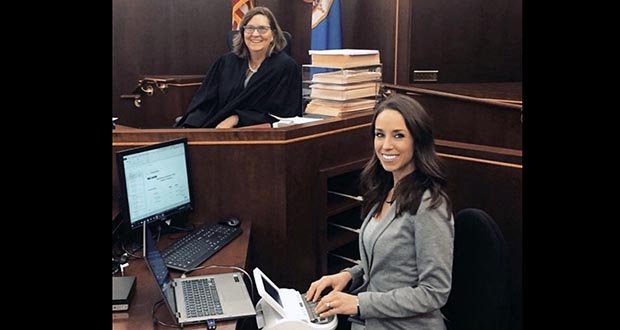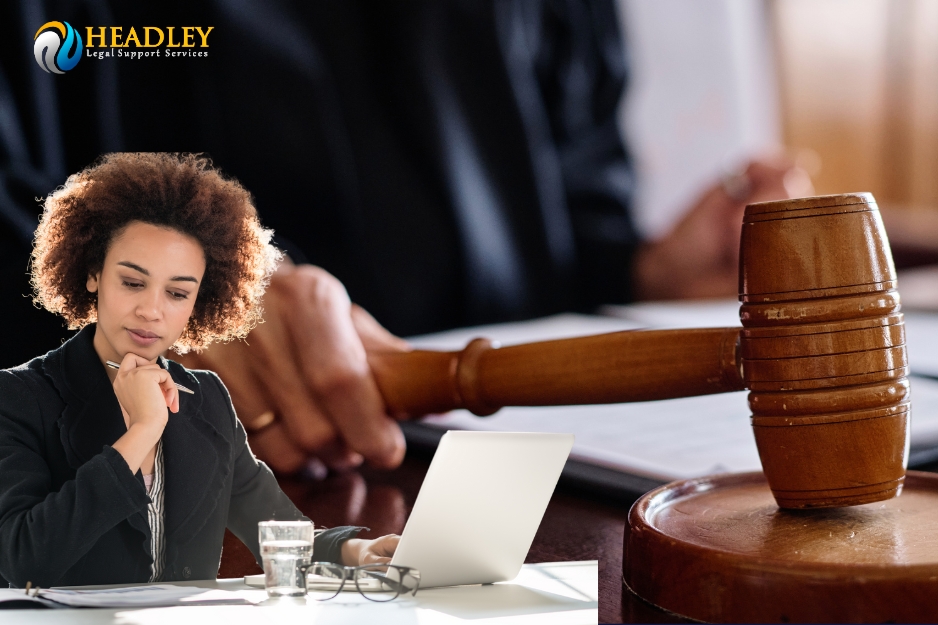The benefits of outsourcing durham court reporting to professionals
How Court Reporting Works: A Step-by-Step Overview to the Lawful Process
Court reporting is a vital element of the legal system. It involves an organized procedure that assures exact paperwork of proceedings. From preparation to the last shipment of transcripts, each action is crucial. Recognizing just how stenotype reporter operate offers insight into the honesty of lawful records. The subtleties of their work can profoundly impact lawful results, prompting inquiries regarding the innovations and methods they use. What are the specific strategies that define this profession?
The Duty of Court Reporters in the Legal System
Stenotype reporter play an important duty in the legal system by giving reputable and accurate records of court proceedings. Their work guarantees that every spoken word throughout tests, hearings, and depositions is documented, which is critical for preserving a main record of occasions. This transcription is fundamental for charms, as it permits higher courts to assess the procedures and determine if any type of mistakes were made during the test.
In addition, court reporters aid in preserving the stability of the lawful process by producing verbatim documents that can be described by lawyers, judges, and various other parties involved in a case. They frequently use specialized equipment and software program to capture dialogue with precision. Past the court room, their transcripts can serve as crucial historic documents, providing understanding right into judicial proceedings and the legal system's functioning. Eventually, court press reporters add significantly to transparency and responsibility in lawful issues.
Getting ready for a Court Reporting Session
Prep work is essential for a successful court reporting session, as it guarantees the accuracy and efficiency of the transcription process. Court reporters begin by examining situation materials, including pleadings and witness lists, to familiarize themselves with the terminology and context. They also ensure that they have the required tools, such as steno devices, notebooks, and back-up devices, on-line.
Before the session, interaction with lawful teams is crucial. Reporters typically clear up any type of particular requests pertaining to format or liked terms. Furthermore, they may arrange to meet lawyers or witnesses to go over the procedures and validate the routine. Showing up early to establish up the tools enables for fixing potential technological problems. In general, extensive prep work not only enhances the press reporter's confidence but additionally adds significantly to producing a precise and clear document of the legal process.

Recording the Document: Techniques and Equipment
Using advanced strategies and trusted equipment, court press reporters thoroughly capture the talked word during legal process. They utilize stenography, an approach including a specialized maker that allows them to kind multiple noises at the same time, therefore transcribing discussion in real time. This maker, known as a steno keyboard, is geared up with tricks that represent words and syllables, enabling swift and precise input.
In enhancement to stenography, court reporters might utilize audio recording devices as supplementary tools. These devices work as backups, making certain that no crucial info is shed during proceedings. Some reporters integrate software program that boosts their transcription effectiveness, supplying features such as voice acknowledgment and automated format.
Proper positioning and focus are critical; press reporters need to keep focus on all audio speakers, recording subtleties and inflections that add to the record. Via a mix of ability and technology, court reporters support the integrity of the legal process by guaranteeing a specific and extensive record of events.
Transcribing the Proceedings
Transcribing the proceedings requires court press reporters to transform talked discussion into composed text with extraordinary accuracy and speed. This procedure typically happens instantly after the recording has actually been recorded, using specialized software that enables smooth transcription. Court press reporters need to listen diligently to the sound, ensuring that every word, inflection, and pause is properly represented in the transcript.
They often rely upon shorthand systems, individual transcription skills, and progressed innovation to facilitate this job. The atmosphere in which they work can be sometimes disorderly and fast-paced, as lawful procedures usually include multiple audio speakers and technical lingo. Stenotype reporter must additionally preserve focus to catch subtleties in tone and context that may be necessary for the legal document. Eventually, the accuracy of the transcription is vital, as it works as a main document for future referral in legal procedures.
Reviewing and Modifying the Records
The process of evaluating and editing and enhancing the transcript is important for guaranteeing precision in court reporting. Court press reporters usually team up with attorneys to make clear any kind of obscurities and confirm the accuracy of the recorded declarations. This collaboration is vital for keeping the integrity of the legal document.
Importance of Accuracy
Accuracy offers as the keystone of effective court reporting, as also small mistakes can significantly change the definition of legal proceedings. The examining and modifying process is essential in making certain that records show the talked word with integrity. Stenotype reporter thoroughly validate names, technical terms, and legal lingo to preserve accuracy. This focus to information aids prevent misunderstandings that can affect case results. In addition, precision fosters trust among lawyers, clients, and the court, enhancing the integrity of the judicial system. Errors can result in disputes or appeals, making it necessary for press reporters to fine-tune their job completely. find out Ultimately, the pursuit of accuracy not just boosts the dependability of the transcript but additionally promotes the criteria of the lawful occupation.
Collaboration With Attorneys
Partnership between court reporters and lawyers is critical throughout the examining and modifying phase of records production. This process assures that the final record properly shows the spoken word and complies with legal standards. Lawyers typically evaluate records for click to read more certain terminology, context, and any kind of possible errors that might affect the case. Court press reporters count on lawyers' expertise to make clear ambiguous areas or highlight essential statements. Efficient communication is vital; attorneys might supply feedback or request corrections, which stenotype reporter must resolve quickly. This collaboration not just enhances the high quality of the records yet additionally adds to a smoother lawful procedure. Eventually, collective initiatives cause a exact and trusted record, essential for future recommendations and legal proceedings.
Supplying the Final Transcript to Customers
Upon conclusion of the transcription process, stenotype reporter diligently prepare the final file for distribution to their customers. This final transcript goes through thorough proofreading to ensure precision, as any kind of mistakes might greatly impact legal procedures. Stenotype reporter layout the document according to the particular demands established forth by the customers or lawful companies, consisting of pagination, indexing, and any type of required exhibitions.

Court press reporters may offer a cover letter summarizing essential details and offering further assistance if required. This thorough strategy warranties that customers get a polished, accurate, and easily accessible records, vital for their legal demands.
Regularly Asked Concerns
What Certifications Are Needed to Come To Be a Court Press Reporter?
To end up being a court reporter, people commonly need a secondary school diploma, conclusion of a court reporting program, and qualification or licensure, depending on state requirements. durham court reporting. Effectiveness in shorthand and innovation is also crucial for success
The length of time Does It Require To Total Court Reporting Training?
Generally, completing court reporting training takes between 18 months to 4 years, depending on the program's strength, the trainee's rate, and the details demands of the territory in which they want to exercise.

What Is the Ordinary Salary of a Stenotype Reporter?
The average income of a stenotype reporter varies by area and experience, normally ranging from $45,000 to $100,000 every year (durham court reporting). Factors such as expertise and need can significantly affect their revenues in different areas
Are Court Reporters Required to Have Qualification?
Stenotype reporter are normally called for to obtain accreditation, which guarantees they possess the needed abilities and knowledge for precise transcription. Accreditation needs can differ by state or jurisdiction, reflecting expert criteria within the lawful community.
Can Court Reporters Job Remotely or Freelance?
Stenotype reporter can function from another location or freelance, providing versatility in their occupation. Lots of make use of modern technology to transcribe proceedings from various locations, enabling varied possibilities in the lawful area while maintaining a work-life balance.
Court reporters play a vital function in the legal system by supplying precise and trustworthy records of court process. In addition, court press reporters aid in maintaining the honesty of the lawful process by producing verbatim records that can be referred to by lawyers, judges, and various other events entailed in a situation. Using sophisticated techniques and dependable equipment, court reporters diligently record the talked word during legal process. Court press reporters should also maintain focus to catch nuances in tone and context that might be necessary for the lawful record. To come to be a court press reporter, individuals generally require a high institution diploma, completion of a court reporting program, and certification or licensure, depending on state needs.